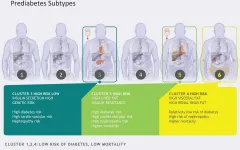Public health messaging in era of social media
2021-01-04
(Press-News.org) What The Viewpoint Says: The rapid spread of scientific misinformation on social media platforms throughout the COVID-19 pandemic is discussed in this Viewpoint, which also proposes strategies to counteract its adverse effects including surveillance of digital data and partnering with trusted messengers to engage the public and advance scientifically sound public health measures.
Authors: Raina M. Merchant, M.D., M.S.H.P., of the University of Pennsylvania in Philadelphia, is the corresponding author.
To access the embargoed study: Visit our For The Media website at this link https://media.jamanetwork.com/
(doi:10.1001/jama.2020.24514)
Editor's Note: The article includes conflict of interest disclosures. Please see the article for additional information, including other authors, author contributions and affiliations, conflict of interest and financial disclosures, and funding and support.
INFORMATION:
Media advisory: The full article is linked to this news release.
Embed this link to provide your readers free access to the full-text article This link will be live at the embargo time https://jamanetwork.com/journals/jama/fullarticle/10.1001/jama.2020.24514?guestAccessKey=63352c09-e602-441a-b8af-d8feac1683cc&utm_source=For_The_Media&utm_medium=referral&utm_campaign=ftm_links&utm_content=tfl&utm_term=010421
ELSE PRESS RELEASES FROM THIS DATE:
2021-01-04
ITHACA, N.Y. - From an observatory high above Chile's Atacama Desert, astronomers have taken a new look at the oldest light in the universe.
Their observations, plus a bit of cosmic geometry, suggest that the universe is 13.77 billion years old - give or take 40 million years. A Cornell University researcher co-authored one of two papers about the findings, which add a fresh twist to an ongoing debate in the astrophysics community.
The new estimate, using data gathered at the National Science Foundation's Atacama Cosmology Telescope (ACT), matches the one provided by the standard ...
2021-01-04
All prediabetes is not the same: in people in the preliminary stages of type 2 diabetes, there are six clearly distinguishable subtypes, which differ in the development of the disease, diabetes risk, and the development of secondary diseases. This is shown in a study by the Institute for Diabetes Research and Metabolic Diseases (IDM) of Helmholtz Zentrum München at the University of Tübingen, Tübingen University Hospital and the German Center for Diabetes Research (DZD). The results have now been published in Nature Medicine. The new classification can help in the future to prevent the manifestation of diabetes ...
2021-01-04
A sugar-binding protein could fuel terrible inflammation and worsen sepsis, a disease that kills more than 270,000 people every year in the US alone, reports a team of researchers led by UConn Health in the 4 January issue of Nature Immunology.
Sepsis is caused mostly by bacterial infections. The immune system runs out of controls and triggers a cytokine storm, a condition in which inflammation-causing proteins flood the blood. Organs may break down, and death often follows.
Other diseases can also cause cytokine storms; medical historians believe cytokine storms were behind the lethality of the ...
2021-01-04
If you type into a search engine - "why do men have to wait before having sex again?" - you will very quickly come across Prolactin. This little hormone is thought to be involved in hundreds of physiological processes in the body. Among them is the male post-ejaculatory refractory period. This period begins when a male ejaculates and ends when he recovers his sexual capacity.
If you search a bit more, you'll see that this theory has even led to the development of so called "treatments". These promise to shorten the length of a person's refractory period by reducing their body's prolactin levels.
Well, here is some bad news for anyone who has bought any such merchandise. A new study in mice by scientists at the Champalimaud Centre for the Unknown ...
2021-01-04
A research study at the University of Chicago has found that in pregnancy, while the T cell response to a fetus becomes tolerant to allow for successful pregnancy, the part of the immune system that produces antibodies (known as the humoral response) becomes sensitized, creating memory B cells that can later contribute to the rejection of a transplanted organ.
The results help to clarify why it is that the immune system can tolerate a fetus during pregnancy, but later may be more likely to become sensitized to and reject an organ transplant. The study was published on January 4, 2021 in the END ...
2021-01-04
Polarons are fleeting distortions in a material's atomic lattice that form around a moving electron in a few trillionths of a second, then quickly disappear. As ephemeral as they are, they affect a material's behavior, and may even be the reason that solar cells made with lead hybrid perovskites achieve extraordinarily high efficiencies in the lab.
Now scientists at the Department of Energy's SLAC National Accelerator Laboratory and Stanford University have used the lab's X-ray laser to watch and directly measure the formation of polarons for the first time. They reported their findings in Nature ...
2021-01-04
Using a new combination of emitter molecules, researchers in Japan have demonstrated the promise of a novel approach to finally overcome a major challenge facing displays using organic light-emitting diodes: a blue light source matching the excellent performance of the red and green ones.
By splitting energy conversion and emission processes between two molecules, the researchers achieved devices that produce pure-blue emission with high efficiency, maintain brightness for relatively long times, and lack any expensive metal atoms--a set of properties that has so far been difficult ...
2021-01-04
Babies who suffer oxygen deficiencies during birth are at risk of brain damage that can lead to developmental delays, cerebral palsy and even death. To prevent this, most women in labor undergo continuous monitoring of the baby's heart rate and receive supplemental oxygen if the heart rate is abnormal, with the thought that this common practice increases oxygen delivery to the baby. However, there is conflicting evidence about whether the long-recommended practice improves infant health.
Now, a comprehensive analysis - led by Washington University School ...
2021-01-04
New Columbia Engineering study--first to investigate the long-term effect of soil moisture-atmosphere feedbacks in drylands--finds that soil moisture exerts a negative feedback on surface water availability in drylands, offsetting some of the expected decline
New York, NY--January 4, 2021--Scientists have thought that global warming will increase the availability of surface water--freshwater resources generated by precipitation minus evapotranspiration--in wet regions, and decrease water availability in dry regions. This expectation is based primarily on atmospheric thermodynamic processes. As air temperatures rise, more water evaporates into the air from the ocean and land. Because warmer air can hold more water vapor than dry air, a more humid atmosphere ...
2021-01-04
ANN ARBOR, Michigan -- Michael Green, M.D., Ph.D., noticed that when his patients had cancer that spread to the liver, they fared poorly - more so than when cancer spread to other parts of the body. Not only that, but transformative immunotherapy treatments had little impact for these patient.
Uncovering the reason and a possible solution, a new study, published in Nature Medicine, finds that tumors in the liver siphon off critical immune cells, rendering immunotherapy ineffective. But coupling immunotherapy with radiotherapy to the liver in mice restored the immune cell function and led to better outcomes.
"Patients with liver metastases receive little benefit from immunotherapy, a treatment that has been a game-changer for many cancers. Our research suggests ...
LAST 30 PRESS RELEASES:
[Press-News.org] Public health messaging in era of social media




